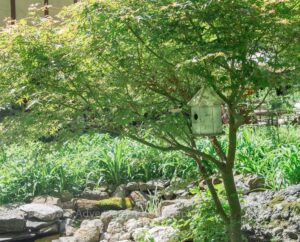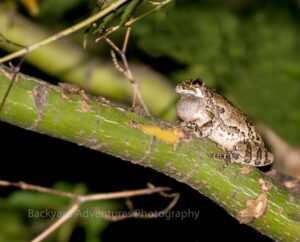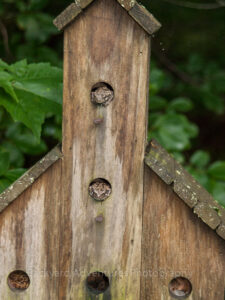One night, a couple of years ago, we heard the most unusual, intense, shrill call from the wild. Being adventurers at heart, we donned flashlights and headed outside to track the call. The loud chorus made it easy to pinpoint the culprit- a gray tree frog! It was in the tree by our pond and he has once again found a home in our tree this summer.
 As their name implies, gray tree frogs spend much of their lives high off the ground, living in trees and shrubs. They are nocturnal creatures, only becoming active after dark to feed on moths, crickets and we hope mosquitoes! They move about the trees with the aid of special pads on their feet. These pads, along with a bit of cticky mucus, allow the frogs to cling to tree trunks and branches. When winter arrives the frogs climb down from the trees and bury themselves under rotting logs or leaf litter. When the ground begins to freeze up, the frogs go into hibernation.
As their name implies, gray tree frogs spend much of their lives high off the ground, living in trees and shrubs. They are nocturnal creatures, only becoming active after dark to feed on moths, crickets and we hope mosquitoes! They move about the trees with the aid of special pads on their feet. These pads, along with a bit of cticky mucus, allow the frogs to cling to tree trunks and branches. When winter arrives the frogs climb down from the trees and bury themselves under rotting logs or leaf litter. When the ground begins to freeze up, the frogs go into hibernation.
When spring arrives the frogs head to the nearest body of water to breed. But unlike most frogs, they don’t spend much time in the water.The male usually climbs onto an overhanging branch and establishes his calling territory at the edge of the pond. If he is lucky enough to attract a female, he hops off his branch and joins her in the water. Who imagined, when we put in our backyard pond, that it would become a breeding ground for tree frogs?
 This tree by the edge of the pond, which also housed this chickadee this summer, is where the tree frog hangs out most nights. The color of the tree frog varies depending on temperature and environment. They can look gray, brown, green, or a combination of all three. They have the ability to change their color to camouflage themselves. Aquatic frogs are able to dive underwater in order to escape danger, but there is no water to hide in at the top of a tree. So, instead of diving, tree frogs simply hide by blending into the background.
This tree by the edge of the pond, which also housed this chickadee this summer, is where the tree frog hangs out most nights. The color of the tree frog varies depending on temperature and environment. They can look gray, brown, green, or a combination of all three. They have the ability to change their color to camouflage themselves. Aquatic frogs are able to dive underwater in order to escape danger, but there is no water to hide in at the top of a tree. So, instead of diving, tree frogs simply hide by blending into the background.
 During the day, tree frogs hide among the tree foliage, while others crawl into crevices and knotholes. If there aren’t any knotholes available, they will also use holes in man-made structures, including holes in barns, sheds, and birdhouses. We have never spotted them during the day in our own backyard but while on a garden tour sponsored by the Lakeville Garden Club, I photographed these tree frogs happily living in a birdhouse at the beautiful gardens of Teri Peterson.
During the day, tree frogs hide among the tree foliage, while others crawl into crevices and knotholes. If there aren’t any knotholes available, they will also use holes in man-made structures, including holes in barns, sheds, and birdhouses. We have never spotted them during the day in our own backyard but while on a garden tour sponsored by the Lakeville Garden Club, I photographed these tree frogs happily living in a birdhouse at the beautiful gardens of Teri Peterson.


I always thought tree frogs were an exotic creature, to be found in tropical locations like Costa Rica. But we discovered they are alive and well in New England, and right in our own backyard!